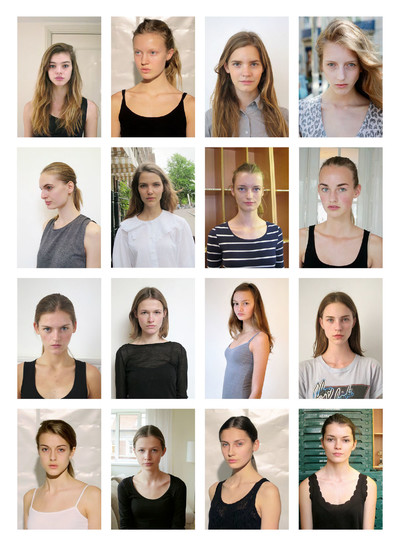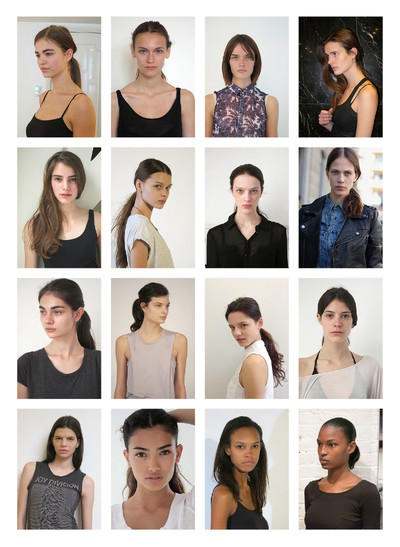Ashley Brokaw is the casting director other casting directors go to.
By Derek Blasberg
Ashley Brokaw is the casting director other casting directors go to.

Ashley Brokaw and I first met under suspect circumstances: someone impersonating my assistant (which wasn’t that clever, since I don’t have an assistant) emailed her asking for the personal details of a new model she had recently cast. Ashley had a funny feeling about the situation, got my email from a mutual friend and contacted me, found out it wasn’t legit and promptly shut it down. This sort of interaction isn’t uncommon for Ashley. People have gone to great lengths to contact her, and not just because they have a crush (or creepy obsession) with a model. As she works with some of the most important image-makers in the fashion industry – most notably Nicolas Ghesquière, with whom she has worked since 2006, but also Miuccia Prada and Proenza Schouler’s Jack McCollough and Lazaro Hernandez – her perspective on the modelling and fashion industries is unique. She has helped foster some of the most influential careers we’ve seen in the past 15 years, first working in Steven Meisel’s studio and more recently as one of the industry’s most important cast- ing directors. That’s why other designers and casting directors want to know who she’s booking, and which girls are on her radar.
But, as I found out when Ashley and I recently met, one of the first lessons she learned was discretion.
I always like hearing about how casting directors start out. You can’t get a casting degree at NYU or anything.
Ashley Brokaw: You’re right. There is no course, and it’s nothing that you can teach. It’s just experience. I started when I was 17. I interned for Juliet Taylor, who was a movie casting director. She does all of the Woody Allen movies. I worked on this movie, which was a total flop, called Shadows and Fog. It was Madonna, John Malkovich, Mia Farrow, and John Cusack. Everybody was in the movie.
Really? Is it bad? I never heard of it.
That was… Oh gosh, in the early 1990s? And no, no one saw it. Around the same time, [Juliet Taylor] was working on Cape Fear, the film where Robert De Niro plays a psychopath with Juliette Lewis. I always found those kinds of movies really fascinating. I would watch a film and think, ‘What if you put this actor in that role instead? Would it be better, would it be worse? How would it be different?’ Then I interned at Seventeen magazine when I was 18, which was a huge deal at the time. I was there for Nikki Taylor’s first cover. And then somehow the two worlds merged. I worked for Bruce Weber for two years and did those Abercrombie and Fitch catalogues, and then I started with Steven Meisel.
So you’ve been casting, literally, since you were 17?
Yeah, strangely. But it’s not at all what I thought I was going to do!
What were you expecting to do?
I went to the Foreign Services School at Georgetown to become a Foreign Service officer – until my senior year when I was like, ‘I can’t do this.’
Did you graduate?
I did. I took a masters course in my senior year on diplomacy in the 21st century. This was right when the transfer of information came out in real time. That redefined what it meant to be a foreign policy officer. It basically meant the job I wanted didn’t exist anymore.
Working in fashion is the ultimate political minefield, it was good training.
That’s true! I have to be diplomatic every day of my life!
So you’d got up to the time when you were working for Meisel?
I left Meisel, and took a year off to move to Paris and do all those things you want to do at 30. I went back to school, the Sorbonne; I took cooking classes.
And after your year of soul searching?
I came back, and the first person to call me was Karl Templer, asking, ‘Can you help out on this French Vogue story?’ He started asking me to help out on little things, which became bigger things. He said, ‘I really like this girl, Daria.’ It was Daria Werbowy. Then he said, ‘Can you put together a story around her and her friends in the Hamptons?’ So I felt like I’d do these little jobs until I figured out what I was going to do. But I never got there…
‘Nicolas is as obsessed with models as I am. When I find somebody that I think would be perfect for him, I’ll send the pictures right away.’
And that’s how you went from French cooking classes to casting Balenciaga.
I started doing shows in New York, and like anything in fashion, it’s word of mouth. I did a show with Marie-Amélie [Sauvé] and got a call a week after that saying, ‘Do you want to come to Paris and help on Balenciaga?’ It was my first Paris show, and it was great. I ended up working with Nicolas for seven years.
How involved is he in the casting?
He is as obsessed with models as I am. I scout for him, and we’re in regular contact. When I find somebody I think would be perfect for Nicolas, I’ll send him pictures right away. He gets as excited as I do when we find somebody. He is very considered about everything.
Everything?
Everything. The hair and the nails and the make-up. For a lot of designers casting can be secondary, and they leave it up to someone else. They don’t know what it means to put on a great show and make a great moment.
What else don’t we know about Nicolas Ghesquière that’s worth telling?
He’s very kind. Fantastic sense of humour, which is so important.
How would you define a typical Ghesquière girl?
Great personality, a bit of masculinity. He loves a tomboy. But one who can still dress up and look beautiful.

A tomboy who can wear high heels?
Exactly. Never soft or mousy. Always has to have a strong sense of self within. They all have that X-factor in terms of toughness. There is nothing precious about a Ghesquière girl!
That was the thing about his Balenciaga shows. Every girl was just cool. I hate to use that word, but these were girls you wanted to hang out with. That’s what he did so well. Some designers could take those same girls, and it doesn’t necessarily translate. He makes girls look cool and authentic. You work with other designers, too?
I do Prada as well. There is a difference between a Prada girl and a Ghesquière girl. The Prada girl is maybe a bit more sexual, more sensual. For example, Vanessa Axente who is kind of a model- of-the-moment, I scouted her, she was very Prada to me. Even when Nicolas met her, he was like, ‘She’s very Prada.’
What’s your scouting routine?
I don’t do street casting, which is very difficult. Most places are very over-scouted, and you’re stopping someone that’s already been stopped a hundred times. I’ll go to different areas of the world and meet with local scouts. Sometimes you’re finding young girls, so you wait for them to grow up and see if they’re right for shows. Other times it’s girls who’ve been around for a while that are just ready. Look at Amanda Murphy, who opened Prada this season; she’s been modelling for a while; I think she’s 22. But she was ready this season.
‘I asked Aymeline, “Would you be willing to cut your hair’ and she said, ‘Well, I’ve got this lingerie job next week.’ I said, ‘Trust me, it’s Balenciaga…’’’
Have new technologies affected your work – platforms like YouTube, Instagram, Twitter? Do you use them to scout? Does a model’s social media presence impact the casting process?
New media is interesting. Sometime I love it, sometimes I loathe it! Some clients like it when models have lots of Twitter followers and have a big social media presence, while others see it as a negative – they can become bigger than the brands they represent. For a smaller brand it can be valuable, but for a bigger brand who wants to use the model as just that – a model – it gets tricky because they have such an established persona. I will say I have found some models through Facebook though!
Do you recognise certain current trends in casting?
I think that the moment you see a trend, it’s going to change.

Do you have any favourite discoveries?
I scouted Aymeline [Valade] when she was a 24-year-old lingerie model in Milan. She came in sneakers, jeans, and a leather jacket; she probably thought it would be a waste of time. But when she walked in, I was like, ‘Job done!’ That was exactly what I was looking for. The particular show was for Nicolas, and he wanted tough girls and to cut their hair. I don’t think she understood what it was all about. So I said, ‘Would you cut your hair?’ and she said, ‘Well, I’ve got this lingerie job next week, and I don’t know if I can cut my hair…’ And I said, ‘Listen, trust me.’
Being in one of these shows can make or break a girl’s career. Are you aware of that responsibility?
Sometimes it works, sometimes not. You can be judged as much on the misses as you are on the hits. It’s a moment; it’s a show. Not all the girls turn into super- models. Not everyone understands that. Sometimes you have a girl that will never do a show again, but everyone is very inspired by her in that look in that show in that section in that moment.
That’s what fashion is: it’s a moment.
And I’m happy to participate in the conversation of how that moment is going to appear.